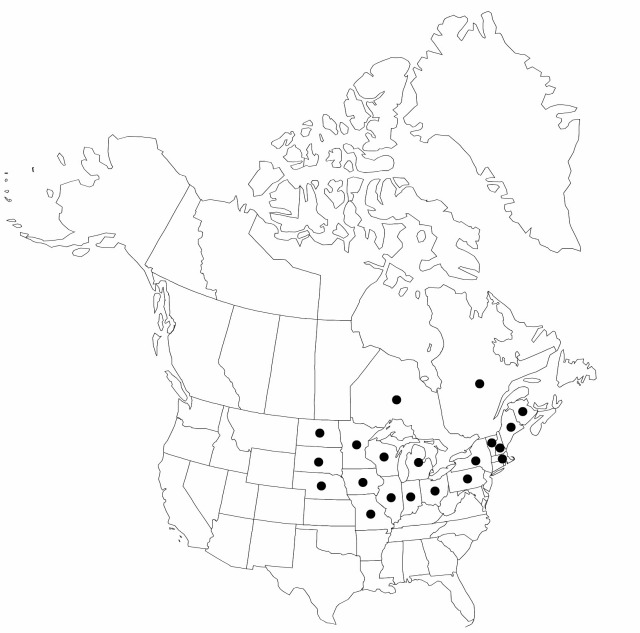Difference between revisions of "Carex haydenii"
Amer. J. Sci. Arts, ser. 2, 18: 103. 1854.
FNA>Volume Importer |
imported>Volume Importer |
||
| (6 intermediate revisions by 2 users not shown) | |||
| Line 8: | Line 8: | ||
}} | }} | ||
|common_names=Carex de Hayden | |common_names=Carex de Hayden | ||
| + | |special_status={{Treatment/ID/Special_status | ||
| + | |code=F | ||
| + | |label=Illustrated | ||
| + | }}{{Treatment/ID/Special_status | ||
| + | |code=E | ||
| + | |label=Endemic | ||
| + | }} | ||
|basionyms= | |basionyms= | ||
|synonyms={{Treatment/ID/Synonym | |synonyms={{Treatment/ID/Synonym | ||
|name=Carex acuta var. erecta | |name=Carex acuta var. erecta | ||
|authority=Dewey | |authority=Dewey | ||
| − | }}{{Treatment/ID/Synonym | + | |rank=variety |
| + | }} {{Treatment/ID/Synonym | ||
|name=Carex rousseaui | |name=Carex rousseaui | ||
|authority=Raymond | |authority=Raymond | ||
| − | }}{{Treatment/ID/Synonym | + | |rank=species |
| + | }} {{Treatment/ID/Synonym | ||
|name=Carex stricta var. decora | |name=Carex stricta var. decora | ||
|authority=L. H. Bailey | |authority=L. H. Bailey | ||
| − | }}{{Treatment/ID/Synonym | + | |rank=variety |
| + | }} {{Treatment/ID/Synonym | ||
|name=Carex stricta var. haydenii | |name=Carex stricta var. haydenii | ||
|authority=(Dewey) Kükenthal | |authority=(Dewey) Kükenthal | ||
| + | |rank=variety | ||
}} | }} | ||
|hierarchy=Cyperaceae;Carex;Carex sect. Phacocystis;Carex haydenii | |hierarchy=Cyperaceae;Carex;Carex sect. Phacocystis;Carex haydenii | ||
| Line 36: | Line 47: | ||
|elevation=0–1,000 m | |elevation=0–1,000 m | ||
|distribution=N.B.;Ont.;Que.;Ill.;Ind.;Iowa;Maine;Mass.;Mich.;Minn.;Mo.;Nebr.;N.H.;N.Y.;N.Dak.;Ohio;Pa.;S.Dak.;Vt.;Wis. | |distribution=N.B.;Ont.;Que.;Ill.;Ind.;Iowa;Maine;Mass.;Mich.;Minn.;Mo.;Nebr.;N.H.;N.Y.;N.Dak.;Ohio;Pa.;S.Dak.;Vt.;Wis. | ||
| − | |discussion=<p>Carex haydenii is a species of seasonally saturated soils in open habitats. It appears to be declining in abundance with changes in land use.</p><!-- | + | |discussion=<p><i>Carex haydenii</i> is a species of seasonally saturated soils in open habitats. It appears to be declining in abundance with changes in land use.</p><!-- |
| − | --><p>Carex haydenii is often confused with C. stricta; it can be identified by the inflated perigynia that are rounded apically, acute scales, and glabrous leaves and sheaths. Only basal sheaths of C. haydenii are ladder-fibrillose. Although often sympatric with C. stricta and C. nigra, no hybrids appear to be formed.</p> | + | --><p><i>Carex haydenii</i> is often confused with <i>C. stricta</i>; it can be identified by the inflated perigynia that are rounded apically, acute scales, and glabrous leaves and sheaths. Only basal sheaths of <i>C. haydenii</i> are ladder-fibrillose. Although often sympatric with <i>C. stricta</i> and <i>C. nigra</i>, no hybrids appear to be formed.</p> |
|tables= | |tables= | ||
|references= | |references= | ||
| Line 46: | Line 57: | ||
-->{{#Taxon: | -->{{#Taxon: | ||
name=Carex haydenii | name=Carex haydenii | ||
| − | |||
|authority=Dewey | |authority=Dewey | ||
|rank=species | |rank=species | ||
| Line 60: | Line 70: | ||
|publication title=Amer. J. Sci. Arts, ser. | |publication title=Amer. J. Sci. Arts, ser. | ||
|publication year=1854 | |publication year=1854 | ||
| − | |special status= | + | |special status=Illustrated;Endemic |
| − | |source xml=https:// | + | |source xml=https://bitbucket.org/aafc-mbb/fna-data-curation/src/2e0870ddd59836b60bcf96646a41e87ea5a5943a/coarse_grained_fna_xml/V23/V23_704.xml |
|genus=Carex | |genus=Carex | ||
|section=Carex sect. Phacocystis | |section=Carex sect. Phacocystis | ||
Latest revision as of 20:42, 5 November 2020
Plants cespitose. Culms acutely angled, 30–115 cm, scabrous. Leaves: basal sheaths red-brown, indistinctly ladder-fibrillose; sheaths of proximal leaves glabrous, fronts with red-brown spots, veinless, apex U-shaped; blades 3–5 mm wide. Inflorescences: proximal bract subequal to inflorescence, 2–4 mm wide. Spikes erect; proximal 2–3 spikes pistillate, 1–5 cm × 4–6 mm, base obtuse; terminal 1–2 spikes staminate. Pistillate scales red-brown, longer than perigynia, apex acute or acuminate, awnless. Perigynia divergent, olive-brown with red-brown spots on apical 1/2, veinless, inflated, loosely enclosing achenes, obovoid, 1.5–2.8 × 1.5–2 mm, dull, apex rounded, papillose; beak green, 0.1–0.2 mm. Achenes not constricted, glaucous. 2n = 54.
Phenology: Fruiting Jun–Aug.
Habitat: Wet meadows, moist prairies
Elevation: 0–1,000 m
Distribution

N.B., Ont., Que., Ill., Ind., Iowa, Maine, Mass., Mich., Minn., Mo., Nebr., N.H., N.Y., N.Dak., Ohio, Pa., S.Dak., Vt., Wis.
Discussion
Carex haydenii is a species of seasonally saturated soils in open habitats. It appears to be declining in abundance with changes in land use.
Carex haydenii is often confused with C. stricta; it can be identified by the inflated perigynia that are rounded apically, acute scales, and glabrous leaves and sheaths. Only basal sheaths of C. haydenii are ladder-fibrillose. Although often sympatric with C. stricta and C. nigra, no hybrids appear to be formed.
Selected References
None.
